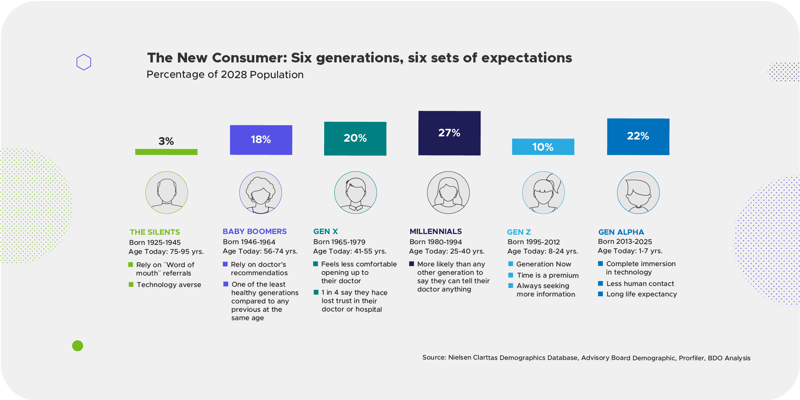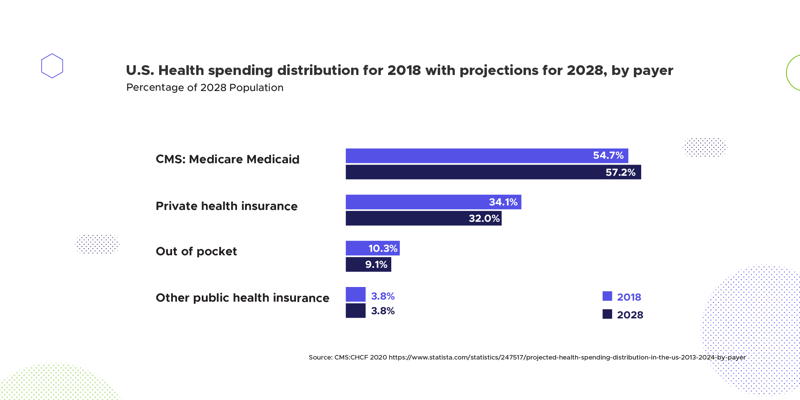Here's how Digital Transformation in Healthcare enhances the Patient Experience and maintains your ROI.
Fact: Maintaining clear and authentic communication with your patients can directly improve their financial viability.
For healthcare facilities to survive on a long-term financial scale, they must reconsider the Patient Experience (PX). This is done by putting patients and their journeys first and foremost. Let's explore how this can be achieved.
The Challenge: Paying Attention to Patient Expectations
Over the last decade, there has been a significant change in the healthcare industry and how care is delivered. It is no longer a simple "doctor's orders" care method. Instead, it has become a collaborative connection between the patient and the healthcare professional, a patient-centered approach to healthcare.
This method of delivery relies on patient input from pre-appointment tasks to any follow-up after the appointment. This is beneficial to both parties as it allows providers to identify gaps, pain points, and opportunities for improvement throughout the patient journey.
Customer insights and market research data suggest that patients prefer easier, more transparent, and affordable healthcare.
- 80% of patients would switch providers based only on convenience, putting “convenient, quick access” ahead of insurance coverage and service quality.
- Before visiting a provider, 92% of patients want to know who is responsible for payment, and 80% prefer online payment systems.
- For an after-hours appointment, 75% of patients prefer telehealth.
By gathering Patient Feedback, healthcare administrators are able to see which areas need improvement and act on them, thus improving the PX and simultaneously boosting the return on investment (ROI).
Investing in PX = Better Financial Viability
A lot is at stake for healthcare organizations: security, privacy, compliance, and, of course, ROI are threatened due to dated processes. A digital transformation is a large investmentthat will reduce risk in these areas, but administrators need to know more before taking the next step. First, does the solution actually match the problem? And, second, how does this help the ROI?
The answer to the first question is simple: YES! By implementing a digital solution, both front and back-end processes are streamlined to increase productivity, decrease time wasted on tasks that can be automated, and reduce the risk of human error. This contributes to a facility with less staff burnout and increased and improved patient attention.
The second question is a bit more tricky to pinpoint as each healthcare facility differs from one another and has different problems and needs that must be addressed. To start, let's explore two areas that help boost the ROI: Patient Satisfaction and Patient Expectations.
- Meet Patient Expectations Across All Generations
Patient feedback allows healthcare providers to analyze what patients are asking for and find solutions to help meet their needs.
Patients share their experiences and it is important to pay attention to what they need and/or are asking for. It has been proven that an organization’s reputation and its capacity to capitalize on market share and reimbursement are directly related.
For years (and more so due to the strains caused by the pandemic), patients have been demading a more personalized and automated method to interact with healthcare facilities. In fact, each generation, has a different set of expectations. Let’s explore.

HCAHPS survey collected information about how patients perceive their care experience. At the same time, counting on this insight, it helps hospitals to improve their systems related to care quality.
In other words, the patient satisfaction survey gives feedback that helps hospitals develop policies and procedures, as well as gives patients a voice in their treatment.
This is crucial for hospitals and healthcare facilities, since patients all around the world have different and also the same needs. So, with this information, healthcare professionals and staff can address what’s necessary to provide a great PX no matter location or generation.
- Maximize Return Through Improved Patient Satisfaction Scores
Creating a great PX can enhance 60% of the factors influencing the volume and timeliness of payment, states BDO’s analysis. In other words, if healthcare providers focus on optimizing processes, training, and communication tactics, PX can be significantly boosted improving ROI and patient health outcomes.

Facts surrounding ROI and the PX:
- The Hospital Value-Based Purchasing program rewards (or penalizes) hospitals based on patient experience scores through financial incentives and public transparency.
- Every dollar of reimbursement, including Medicare reimbursements connected to the patient satisfaction section of the Hospital Consumer Assessment of Healthcare Providers and Systems (HCAHPS) survey, is crucial to financial health.
- Poor survey results in hospitals losing a percentage of potentially eligible Centers for Medicare & Medicaid Services (CMS) reimbursements.
- Currently, CMS withholds 1% of Medicare payments, 30% of which are linked to HCAHPS survey results.
- Because the medicare population is expected to grow from 54 million beneficiaries today to more than 80 million beneficiaries by 2030 (representing more than 25% of total health spending by 2028), CMS will only grow more important as a payer for providers.
- As a result, optimizing potential compensation to the greatest extent possible becomes an even more pressing commercial priority for hospitals and other providers.
Q-Flow: ACF Technologies’ Solution for the Healthcare Industry
With Q-Flow, patients have access to effortless, efficient and pleasant experiences. This software combines solutions such as telemedicine, virtual queuing, and appointment scheduling to enhance both patient and staff experience.
Q-Flow has helped providers, such as Fingers Lake Health and Wake Forest Baptist Health, to:
- Reduce costs with seamless integrations.
- Eliminate duplicate entries with consolidated systems.
- Automate patient flow.
- Deliver faster transfers and patient throughput.
- Create a less stressful environment for staff with improved working conditions and increased patient scores.
- Drive operational improvements through real-time and predictive analytics.
Enhancing the patient experience at your healthcare facility is possible, and at ACF Technologies, we aim to help each healthcare department take a step toward the next level of digital transformation.
Take the next step and schedule a demo with one of our experts.




